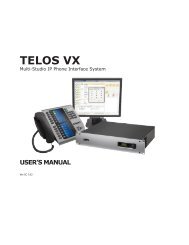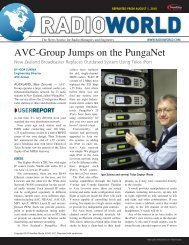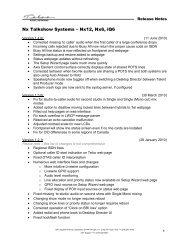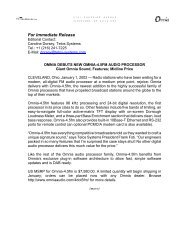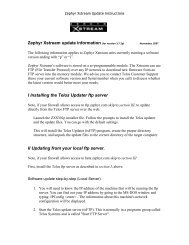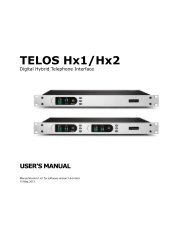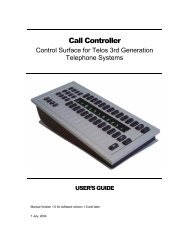NOW! 12-13 - Telos
NOW! 12-13 - Telos
NOW! 12-13 - Telos
Create successful ePaper yourself
Turn your PDF publications into a flip-book with our unique Google optimized e-Paper software.
WHY IS AoIP SO GOOD?<br />
TECHTALK BLOG<br />
TELOSALLIANCE.COM/BLOG<br />
It’s high tech at an affordable price. There could be many different<br />
answers to the question above, but this is probably the<br />
most fundamental one. AoIP leverages decades’ worth of huge<br />
investments by the computer and data networking industry,<br />
offering extremely high technology at mass-market prices.<br />
Custom-designed systems often offer either high technology<br />
or an affordable price, but very rarely both at once. The ability<br />
to do so shines a very favorable light onto AoIP.<br />
The following points are, to a great extent, the beneits of this.<br />
High technology allows building eficient and intelligent applications,<br />
which is what AoIP solutions have always been about.<br />
Universal network infrastructure. The inherent capability of<br />
IP networks to multiplex a variety of protocols and applications<br />
on common cabling and interfaces accommodates nearly anything,<br />
and in any combination. So the network infrastructure<br />
can be shared by many very different tasks – audio streaming,<br />
machine control, program metadata, even regular ofice work.<br />
Huge bandwidth over a compact physical media. The most<br />
common lower-layer transport media for IP is Ethernet. Everyone<br />
knows how thin an Ethernet cable is, but in terms of raw<br />
digital bandwidth, a 1Gb/s Ethernet link is equivalent to about<br />
300 AES-3 links, or about 500 E1’s, or about 650 T1’s. Which<br />
means signiicant savings on both the space requirements and<br />
cost of the cabling.<br />
See the empty cable tray?<br />
This is what happens when one plans for TDM, but gets AoIP.<br />
Flexibility and scalability. Huge physical bandwidth and<br />
packet switching make IP networks nearly limitlessly lexible.<br />
You can easily allocate the entire bandwidth of a 10 Gb/s IP/<br />
Ethernet link to a single media stream — or use it to deliver<br />
one million low-idelity audio feeds. IP-based solutions scale<br />
easily; any newly installed or reserved capacity can be instantly<br />
allocated for any purpose – no system coniguration, and no<br />
network redesign needed. This greatly simpliies planning and<br />
building audio applications, and opens the door to convergence<br />
of audio and video handling systems.<br />
BROCHURES<br />
AXIAAUDIO.COM/BROCHURES<br />
SOFTWARE UPDATES<br />
AXIAAUDIO.COM/DOWNLOADS<br />
Ability to operate over different lower layer technologies.<br />
While the copper Ethernet LAN is doubtlessly the most widely<br />
used MAC/physical layer for IP, the IP protocol itself is not<br />
bound to any speciic underlying protocol or physical transmission<br />
media. To mention just a few most widely known technologies,<br />
IP can be carried also over ISDN, ATM, MPLS, IEEE <strong>13</strong>94, or<br />
DSL links. This fact makes the IP-based transport nearly futureproof,<br />
thanks to its ability to propagate through various network<br />
types, including mixed-technology ones, and the ability to<br />
survive evolutionary changes in the carrier networks.<br />
Virtual soundcards. A small detail? In fact, it is huge. No other<br />
technology but AoIP allows converting a regular PC into a highquality<br />
multi-channel sound card array without spending a cent<br />
for special hardware. The cost of expensive hardware sound<br />
cards is crossed off the list and replaced with a software component<br />
at a small fraction of that cost.<br />
The opportunity to use standard software. Being IP-based,<br />
AoIP can immediately beneit from many useful tools developed<br />
by the Internet community for rather different purposes.<br />
» IP audio can easily be monitored on a regular PC, using<br />
standard audio player software.<br />
» Device management is made easy – all that you need is a<br />
standard web browser. One might argue that a non-IP system<br />
can do that too, and in fact many do, but it costs to add yet<br />
another hardware interface and a network link just to serve<br />
this one purpose. An AoIP device can get it for no additional<br />
hardware cost, excepting the tiny fraction of the link band-<br />
width that the HTTP management takes.<br />
» Inexpensive, up to completely free, diagnostic tools are<br />
LIVEWIRE<br />
available for development and most ield troubleshooting<br />
needs. Usually a network protocol analyzer is an expen-<br />
sive piece of equipment, and it may get even worse with<br />
a closed proprietary system, where the manufacturer may<br />
prefer to keep the technical secrets and restrict availabil-<br />
ity of monitoring and analysis tools to the authorized per-<br />
sonnel only. IP networks are probably the only exception,<br />
where complex monitoring and analysis is feasible without<br />
any investment in tools – on a standard PC, using free soft-<br />
ware like WireShark, for example.<br />
Why, exactly, is Livewire so popular? Here are a few reasons:<br />
» It’s an open solution, built on the basis of standard tech-<br />
nologies.<br />
» It ensures a less-than-1ms network hop delay for low-la-<br />
tency audio streams, and can accommodate over 10,000<br />
sources in every isolated network.<br />
» It employs standard IP over switched Ethernet as the car-<br />
rier network, and RTP/UDP for audio transport – no propri-<br />
etary schemes.<br />
FIND A DEALER<br />
AXIAAUDIO.COM/BUY<br />
IP-AUDIO STUDIO NETWORKING | AoIP CONSOLES | AUDIO INTERFACES | IP INTERCOMS | ROUTING AUTOMATION<br />
AXIAAUDIO.COM<br />
99



